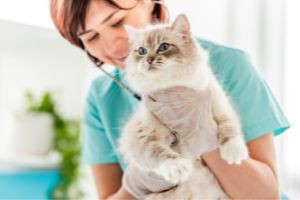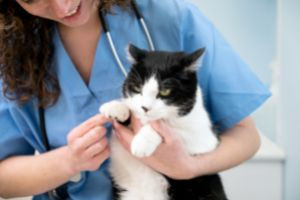Cats, often lauded as the perfect pets, bring joy and companionship into our lives with their graceful movements, charming personalities, and comforting purrs. However, even these delightful creatures can present challenges. One of the most frustrating issues cat owners face is Cat Peeing Everywhere, a problem that can test even the most patient pet lover. As feline-focused veterinarians, we understand this concern deeply. While cats are wonderful companions, their urinary systems can be prone to issues, leading to what seems like unwanted behavior.
 Veterinarian examining a cat for urinary problems, highlighting the importance of veterinary care for cats peeing everywhere due to potential medical issues.
Veterinarian examining a cat for urinary problems, highlighting the importance of veterinary care for cats peeing everywhere due to potential medical issues.
Cat Urinary Problems: A Common and Frustrating Issue for Owners
Dealing with cat peeing everywhere is an incredibly common reason for cat owners to seek veterinary advice. It’s a situation many veterinarians encounter daily: frustrated owners at their wit’s end, saying things like, “My cat is peeing on the rug, the laundry, even my new handbag! I’m about to make her an outdoor cat or worse if you can’t stop this cat peeing everywhere!”
We sympathize. The odor of cat urine is pungent and persistent. But beyond the smell and the damage, cat peeing everywhere is a sign that something isn’t right with your feline friend.
The Frustrating Aspects of Cat Urinary Issues:
- Occurs in Seemingly Healthy Cats: It often affects young, otherwise healthy cats, making it even more perplexing.
- Often No Clear Cause: Pinpointing the exact cause of cat peeing everywhere can be challenging, adding to the frustration.
- Prevention is Difficult: There’s no guaranteed way to prevent urinary issues in cats, making owners feel helpless.
- No Known Cure: Many urinary conditions in cats are managed, not cured, requiring ongoing attention.
- Potentially Life-Threatening: Some urinary issues can become serious and even life-threatening if left untreated.
- Costly Property Damage: Cat peeing everywhere can lead to significant damage to carpets, furniture, and other household items.
- Emotional Toll on Everyone: The stress of dealing with cat peeing everywhere affects not only the cat but also the entire household.
- Contributes to Shelter Overpopulation: Inappropriate urination is a leading cause of cats being surrendered to animal shelters.
It’s understandable to feel overwhelmed when dealing with a cat who is peeing everywhere. It’s a problem that affects countless cat owners. In fact, inappropriate urination is a leading reason why cats end up in shelters.
Widespread Nature of Cat Urinary Tract Issues
It’s estimated that around 1.5% of cats in the United States are experiencing a feline urinary tract disorder at any given time. When you consider the vast number of cat-owning households, this translates to hundreds of thousands of cats struggling with urinary issues. So, if your cat is peeing everywhere, remember you are not alone. It’s not just your cat; this is a common feline problem.
The natural human inclination is to attribute human emotions to this behavior. We might think the cat is being spiteful, angry, or lazy. However, cats don’t operate on these complex emotions. Cat peeing everywhere is rarely, if ever, due to spite or intentional misbehavior.
Rule Out Medical Causes First When Your Cat is Peeing Everywhere
Important Tip: Bladder Infections are Rarely the Culprit in Cats Peeing Everywhere (Less than 2% of Cases)
Humans are often conditioned to associate bladder issues with infections. However, in cats, bacterial urinary tract infections (UTIs) are surprisingly uncommon as a primary cause of cat peeing everywhere. Studies show that only about 2% of cats presenting with urinary problems actually have a bacterial UTI.
While the pet food industry often promotes diets to address urinary crystals, these are also not the main cause in most cases. Struvite or oxalate crystals are found in only around 20% of cats with urinary issues.
This means that in a significant majority – around 78% – of cats exhibiting urinary symptoms or peeing everywhere, there’s no infection, no crystals, no tumors, or any other identifiable medical cause. These cats may have some blood in their urine and certainly have frustrated owners, but the underlying reason for their cat peeing everywhere remains a mystery. Sometimes, cat bladders simply become irritated for no apparent reason.
It’s important to understand that while veterinarians will often prescribe antibiotics and/or special diets, these are often precautionary or to manage potential secondary issues. Don’t expect a quick fix with medication or diet alone when dealing with cat peeing everywhere. The problem may not resolve immediately, and recurrence is possible. Having realistic expectations is crucial when addressing feline urinary tract issues.
So, what triggers a cat’s bladder wall to become inflamed, bleed, and cause irritation, leading to cat peeing everywhere? The exact cause is often unknown. And why does this irritation lead to urination outside the litter box? Why can’t they just strain in their designated litter area? These are questions veterinarians grapple with. It seems cats, when experiencing bladder discomfort, tend to express their distress by peeing everywhere else but their litter box.
The key takeaway here is: if your cat starts peeing everywhere, a veterinary visit is the first and most crucial step. However, be open-minded. Veterinarians are not just about prescribing antibiotics. They have a range of diagnostic and treatment approaches. The issue may not be a simple infection, and understanding the complexity of the feline urinary tract is essential for effective management.
Diagnostic Tests Your Vet May Perform:
To rule out medical reasons for cat peeing everywhere, your veterinarian will likely conduct a series of standard tests:
- Complete Physical Examination: A thorough check-up to assess your cat’s overall health.
- Urinalysis: A urine sample analysis to check for infection, crystals, blood, and other abnormalities.
- Urine Bacterial Culture: To specifically identify if a bacterial infection is present in the urine.
- Bladder X-rays (Radiographs): To look for bladder stones or other structural abnormalities.
These tests help rule out medical conditions before considering behavioral factors as the primary cause of cat peeing everywhere.
The Behavioral Diagnosis: Anxiety and Cat Peeing Everywhere
It’s critical to understand that cats don’t pee on your belongings out of spite or anger. These are not emotions cats are capable of in the way humans understand them.
A cat who is peeing everywhere is almost always experiencing anxiety. To understand why your cat is peeing everywhere, you need to think like a cat and consider their environment from their perspective. What might be causing your cat stress?
 Anxious cat at the vet for urinary problems, illustrating the link between stress and behavioral issues leading to cats peeing everywhere.
Anxious cat at the vet for urinary problems, illustrating the link between stress and behavioral issues leading to cats peeing everywhere.
Addressing Behavioral Inappropriate Urination in Cats
Why does anxiety manifest as cat peeing everywhere? The exact mechanism isn’t fully understood, but addressing the anxiety often resolves the inappropriate urination. This might involve environmental changes, increased attention, or, in some cases, medication like Prozac to manage anxiety.
Key Principles for Managing Cat Peeing Everywhere Due to Behavioral Issues:
1. Cats Value Independence:
In multi-cat households, resource competition and social stress are common. Each cat often prefers its own litter box and may avoid sharing. The rule of thumb is to have one more litter box than the number of cats in your home.
2. Cats Value Safety:
Every cat needs safe, unobstructed access to litter boxes. If a cat feels threatened or blocked from reaching the litter box by another cat, it may choose to urinate elsewhere. Ambushing at the litter box is a common source of stress. Consider the litter box cover – does it make your cat feel trapped? Observe your cats’ interactions around the litter box. Ideally, litter boxes should be in separate rooms or on different floors to minimize inter-cat stress.
3. Cats Value Privacy:
Litter boxes should be placed in quiet, low-traffic, stress-free locations. Bathrooms or closets are often good choices. Avoid placing litter boxes near noisy appliances like washing machines or furnaces. Cats value their personal space, especially when vulnerable. In homes with multiple cats, the likelihood of dealing with inappropriate urination increases significantly due to social dynamics and stress.
Addressing Personal Preferences to Stop Cat Peeing Everywhere:
1. Cats Value Cleanliness:
Cats are meticulous groomers and prefer a clean environment. A soiled litter box, especially with urine residue, is unappealing. Scoop litter boxes at least twice daily and completely empty, scrub, and refill them weekly. Maintaining clean litter boxes is much easier than cleaning cat pee from your belongings.
2. Cats Value Consistency:
Cats are creatures of habit and often develop strong preferences for litter type. Most cats prefer clumping clay litter. Changing litter type or brand can be a significant stressor and trigger cat peeing everywhere.
3. Cats Value Their Sense of Smell:
Many cats are sensitive to strong scents. Heavily perfumed litters, including those marketed for multi-cat households (which often contain more perfume), can be off-putting. If your cat is peeing everywhere, switch to unscented clumping clay litter.
4. Cats Value Pheromone Signals:
Changes in the home environment, such as new furniture, people, or the absence of familiar individuals, can cause anxiety. Using a feline pheromone diffuser like Feliway can help. Feliway mimics the pheromones cats use to mark safe and familiar territory, helping them feel more secure in their environment and reducing anxiety that can lead to cat peeing everywhere.
Understanding Spraying vs. Inappropriate Urination
It’s important to differentiate between spraying and inappropriate urination. Spraying is a territorial marking behavior where a cat backs up to a vertical surface, wiggles its tail, and sprays a small amount of urine. Neutering can often reduce spraying, especially if done early in life. However, spraying can become a learned behavior, requiring help from an animal behaviorist.
Spraying is a marking behavior, while inappropriate urination, the focus of this article, is generally linked to anxiety or medical issues. Cat peeing everywhere in larger volumes, outside of a vertical marking context, is usually inappropriate urination.
In conclusion, if your cat is peeing everywhere, the first step is a veterinary check-up to rule out medical causes. If medical issues are excluded, consider behavioral and environmental factors. By understanding your cat’s needs and addressing potential stressors, you can often resolve the issue of cat peeing everywhere and restore harmony to your home – and save your rugs!

